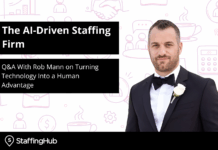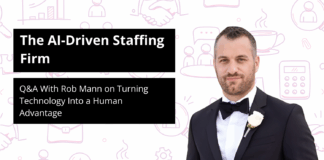
Key takeaways:
- Integration drives profitability and AI readiness: Without seamless data flow between your ATS, CRM, and engagement platforms, you’re operating below capacity. Integration isn’t an IT issue — it’s a board-level growth driver that directly impacts recruiter productivity, forecasting accuracy, and your ability to leverage AI for faster, smarter placements.
- Data silos are silent margin killers: Fragmented systems create duplicate work, inconsistent reporting, and missed revenue opportunities. Unified data unlocks automation.
- A clear integration roadmap protects ROI: Success depends on defining your system of record, auditing API limits, and partnering closely with vendors. Start with measurable goals (e.g., cut manual re-entry by 75%), pilot one workflow, and track metrics like duplicate rate, mean time to data, and submittal-to-hire improvement to prove value and scalability.
Why integration is a board‑level priority
If your applicant tracking system (ATS), customer relationship management (CRM) platform, and candidate engagement tools don’t communicate, your growth engine is idling.
Across industries, organizations now run hundreds of apps. A survey of IT leaders found an average 897 applications per company, yet 66% still don’t provide an integrated user experience and 95% say integration is a hurdle to implementing AI effectively. That’s a red flag for staffing firms trying to capture demand while deploying AI to speed sourcing and submittals.
Sales organizations also struggle with trust in data quality — only 35% of sales pros completely trust their data, which has obvious implications for pipeline forecasting and client development inside staffing CRMs.
Bottom line: Integration is a prerequisite for AI, predictable reporting, and margin protection.
The most common ATS‑CRM‑engagement integration pain points
- Duplicate data entry and drift: Recruiters re‑type jobs, contacts, and candidate updates in multiple systems, creating conflicting versions of the truth.
- Unclear data ownership: Who “owns” a candidate, client, or job order field — ATS or CRM? Without rules, data flips back and forth.
- Event timing gaps: Some platforms push updates in real time, while others batch nightly. That mismatch breaks automations (e.g., nurture campaigns firing on stale statuses).
- Field mismatches and customizations: Custom fields in your ATS rarely map 1:1 into CRM or engagement tools without translation.
- API limits and brittle connectors: Rate limits, pagination, and version changes can throttle syncs or break “native” connectors.
- Reporting inconsistencies: Leadership dashboards don’t align because each system calculates key metrics differently.
- Security and compliance friction: Permissions, consent tracking, and audit trails need to move with the data.
These pain points compound the “data silo” dynamic. Nearly 70% of organizations cite data silos as a top concern for 2025, up seven points year over year.
The true cost of data silos in staffing
- Lost recruiter hours: In Bullhorn’s 2025 GRID, firms predicted AI could save 17 hours per recruiter per week, much of it tied to repetitive tasks like searching, screening, admin, and submittals — the same tasks that balloon when systems aren’t integrated.
- Missed revenue opportunities: GRID also shows top‑performing agencies were 57% more likely to be in advanced stages of digital transformation and those automating search/match and screening were at least twice as likely to have 10% or higher revenue growth. Poor integration slows that automation.
- Blocked AI ROI: If your ATS/CRM/engagement data isn’t flowing, your AI copilots train on incomplete records. Across industries, 95% of IT leaders say integration challenges hinder effective AI adoption.
- Inconsistent board reporting: When sales, recruiting, and finance pull from different “truths,” forecasts swing and confidence erodes. Only 35% of sales teams fully trust their data today.
How to evaluate your integration options
- Tie integration to commercial outcomes: Choose two or three business results (e.g., reduce time‑to‑submit by 24 hours, raise submittal‑to‑hire by 2 points, cut manual re‑entry by 75%).
- Map the flow: Document how a job order, candidate, submission, placement, company, and contact move across ATS, engagement, CRM, and back office. Note every trigger and field.
- Name the “system of record”: For each domain, pick the source of truth (e.g., candidate and job/placement in ATS, account/contact/opportunity in CRM). Write survivorship rules for conflicts.
- Audit vendor APIs: Confirm authentication (OAuth vs. API key), events/webhooks, rate limits, and field coverage (custom fields, attachments, notes, activity).
- Choose an approach: Options include native connector (fastest start, limited flexibility), iPaaS (Integration Platform as a Service) for low‑code orchestration, or custom/event‑driven integration for the most control. Use complexity, data volumes, and vendor limits to decide.
- Design the data model: Define canonical fields and IDs, required/optional fields, valid values, and normalization rules (phone/email formats, status picklists).
- Plan throttling and retries: Respect per‑minute/day limits, implement back‑off, and design idempotent upserts to avoid duplicates.
- Pilot one “thin” workflow: An example of this is a new job order, to matched candidates, to outreach sequence, to submission. Prove latency, data accuracy, and recruiter adoption.
- Instrument everything: Log API error rates, end‑to‑end latency (ATS update to CRM visible), duplicate rate, and data completeness.
- Operationalize: Add runbooks, sandbox parity, version‑upgrade playbooks, and a monthly vendor review.
Vendor relationship management: Getting support for integration projects
- Ask for a sandbox and sample data: You will need a safe place to test mappings and events.
- Secure an integration SLA: Include response times for API incidents and deprecation notices.
- Escalate via partner programs: Avionté offers a Certified Integration Program with access to engineers and event/webhook guidance. Similar programs exist across the ecosystem.
- Co‑write use cases: Give vendors explicit payloads and triggers (e.g., “When a submission status changes to client interview, send to CRM within 2 minutes”).
- Coordinate upgrades: Subscribe to changelogs, and test against new API versions early.
Creating a single source of truth (SSOT) for candidate and client data
A single source of truth doesn’t mean “one system for everything.” It means one agreed owner for each entity and a shared, governed model.
- Own the right domains:
- ATS: Candidate, job order, submission, placement.
- CRM: Account/client, contact, opportunity (job req prospect), activities tied to sales.
- Use canonical IDs: Persist ATS IDs in CRM and engagement tools and vice versa for client IDs. Never match only on name or email.
- Adopt survivorship rules: For example, the ATS is authoritative for candidate status and skills, while the CRM is authoritative for client industry and billing contacts.
- Normalize everything: Standardize picklists (e.g., “submitted” vs “client submitted”), phone/email formats, and address schemas.
- Close the loop with events: Use ATS and engagement webhooks/events where available to push real‑time updates. Fall back to scheduled deltas for systems without events.
Why this matters: Organizations say data silos are their top concern, and leaders that prioritize unified strategies (governance plus integration) are pulling ahead.
Measuring integration effectiveness (success metrics to track)
Operational:
- Duplicate entry rate: Percentage of records edited in more than one system within 24 hours. Target a steady decline.
- “Mean time to data” (MTTD): Time from ATS/CRM changes to visibility across tools. Aim for minutes, not days.
- API health: Error rate, retries, and percentage of calls within rate limits.
Recruiting and sales outcomes:
- Time‑to‑submit/time‑to‑fill: Should compress as integration removes manual steps.
- Submittal‑to‑hire percentage: Clean, connected data improves matching and follow‑through.
- Revenue linkage: In Bullhorn’s GRID, firms that automated search/match and screening were 2 times more likely to grow revenue 10% or more. Track whether your automation‑enabled integrations drive similar lift.
Data quality
- Completeness: Percentage of mandatory fields populated in the single source of truth (SSOT).
- Consistency: Fewer conflicting values across ATS/CRM for the same record.
- Trust: Survey “data trust” quarterly and aim to beat the broader benchmark, where only 35% fully trust their data.
FAQ for staffing leaders
Q: What’s the fastest path to value — native connector, iPaaS, or custom build?
A: If your needs are standard and your volumes modest, start with a native connector. If you need orchestration across several systems and want visual governance, an iPaaS (Integration Platform as a Service) is a good middle road. Choose custom/event‑driven when you have unique workflows, high volumes, or must respect strict API limits and platform event quotas.
Q: How do we stop duplication between ATS and CRM?
A: Establish system‑of‑record ownership per entity, persist canonical IDs in both systems, and use UPSERT operations and webhooks/events where possible to propagate changes rather than recreate records.
Q: Where should candidate engagement data live?
A: Engagement platforms specialize in multi‑channel outreach and journeys. Sync campaign results and key interactions back to ATS/CRM for reporting and a 360° view. Use batched UPSERTs to stay inside rate/size guidelines.
Q: How do we govern vendor changes?
A: Subscribe to your vendors’ changelogs, require pre‑production sandboxes, and align contracts to include version support/deprecation windows.
Q: What evidence shows integration pays off?
A: Agencies that advance automation (which depends on good integration) show meaningful revenue advantages. Integration also unlocks AI — a majority of today’s IT leaders report integration blocking AI.
Your tech stack integration is a growth strategy, not a plumbing project. Treat the ATS, CRM, and engagement platform as a single revenue system with clear ownership, real‑time eventing where possible, and metrics that prove value. When you do, you’ll reduce manual work, unlock AI, and make your board reports — and your margins — far more predictable.





